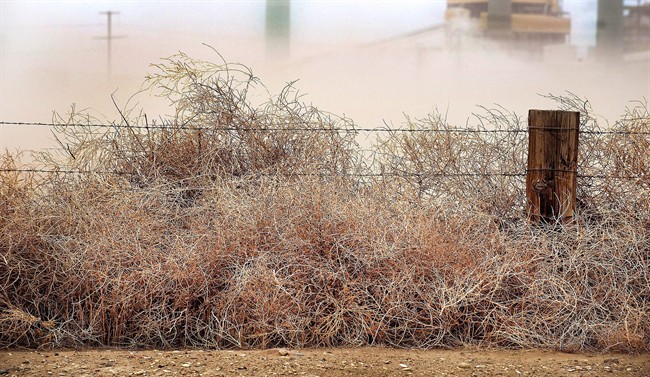ORDWAY, Colo. – Mini-storms of tumbleweed have invaded the drought-stricken prairie of southern Colorado, blocking rural roads and irrigation canals, and briefly barricading homes and an elementary school.

Firefighters even had to cut a path through them to get to a pregnant woman who feared she’d be trapped in her home if she went into labour.
The invasion of the tumbleweed, an iconic symbol of both the West’s rugged terrain and the rugged cowboys who helped settle it, has conjured images of the Dust Bowl of 80 years ago, when severe drought unleashed them onto the landscape.
“It never ends,” said Chris Talbott, as he used a snow shovel to push the weeds off his lawn into a stack on the street in Colorado Springs.
The latest drought, which began in 2010, has created tumbleweed trouble in parts of New Mexico, Oklahoma and Texas. Desiccated Russian thistle, a woody leafy plant, and kochia (KOH’-sha), both invasive weeds from Eurasia, are the culprits.
In Colorado, herds of cattle would eat the tumbleweed, helping to keep it in check, but many ranchers in recent years have reduced or gotten rid of their animals because of the drought. After the first winter freezes in November, the plants broke loose and began rolling with the wind.
“They looked like sheep running across the prairie because the whole prairie was alive,” Ordway rancher Doug Tecklenburg said of a March 15 wind storm. He’s taken to driving with a pitch fork in his truck to get through clogged roads.

Get daily National news
For municipal authorities, there’s a big price tab for that tumbleweed.
Crowley County, high plains country of ranching and farming east of Pueblo in southern Colorado, has spent $108,000 since November – more than a third of its annual budget – clearing roads and bridges of tumbleweed to make sure residents and emergency vehicles can move.
It’s labour-intensive work. “Gathering tumbleweeds is like gathering kindergarteners with a bunch of balloons and trying to keep them in one location,” said Russell Bennett, a county roadman employed by Crowley County.
El Paso County, which includes Colorado Springs, has spent $209,000.
“Try pushing them with heavy equipment and they just roll on you, fly over the top,” said Alf Randall, the county’s acting public works director. “The frustrating part is once you get the first wave beat down, packed down and out of the road, the wind comes up and here comes the next batch.”
Aside from the roads, the tumbleweeds have buried cars and blocked houses in new developments on the outskirts of Colorado Springs.
Officials have tried to attack the tumbleweed with snow blowers and rotary attachments on tractors used to cut crops like alfalfa. They’ve even tried to bale it for cow feed. But the wiry, springy weed clogs machinery, and baling is too expensive to be economical.
Burning it is another option – one authorities are wary of in wildfire-prone Colorado.
Some residents have suggested making biofuel pellets out of the weed. “We’re really not set up for that,” said Crowley County Commissioner Gary Gibson. “If anybody wants to do that, all I can say is, if they want to come down here, they’re welcome to.”
Bennett, the roadman, cobbled together a device from bit pieces of machinery, leftover steel from a bridge project and belts donated by a neighbour. The device, which looks like an old fashioned push mower, grinds tumbleweed to dust.
The county is using the machine, christened “Puff the Magic Dragon,” to clear weeds off roads.
County Commission Chairman Tobe Allumbaugh said other counties have contacted him about how to build one.
More work is in store. Irrigation ditches that crisscross the region have snagged tons of tumbleweed. All of it will have to be cleared so that farmers and cattle ranchers can water their fields and pastures.
Given the cost, at least three Colorado counties – El Paso, Crowley and Pueblo – are considering local states of emergency that would allow them to seek financial help from the state.
At his county commission office, Allumbaugh played for a reporter a song called “Tumbling Tumbleweeds” – popularized by Gene Autry’s 1935 film of the same name – and said that people often think of it as they dismiss tumbleweeds as a harmless bit of nostalgia of a wide-open West.
He said he has even drawn snickers when he mentions that the county has a “tumbleweed emergency.”
“What we have is not funny,” he said.







Comments